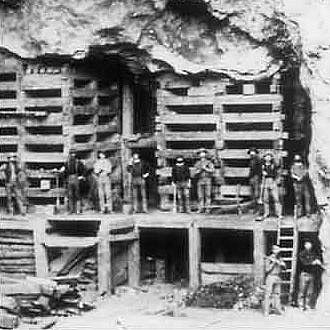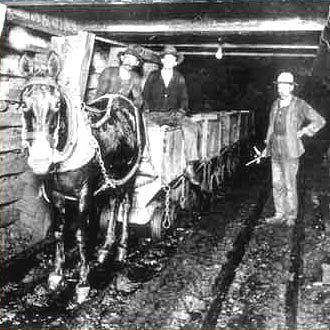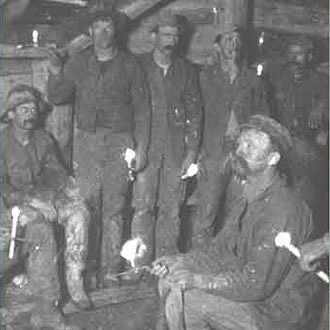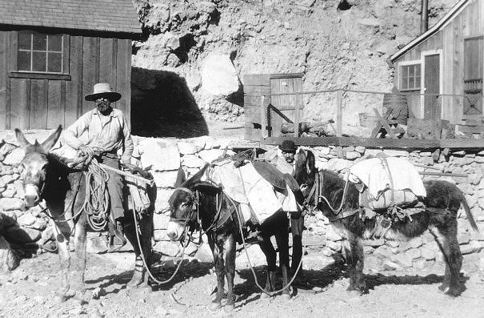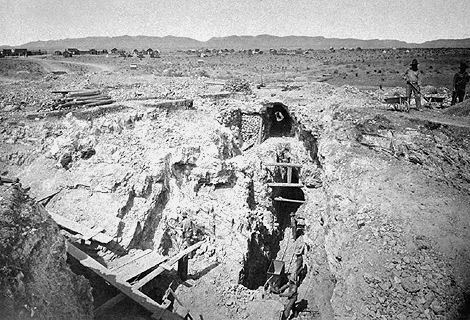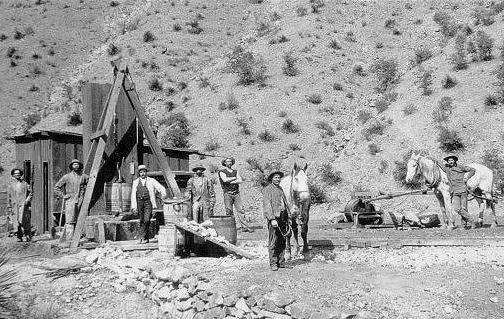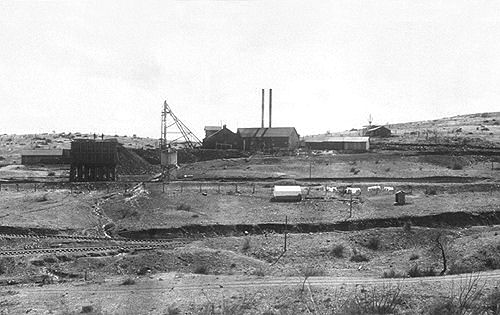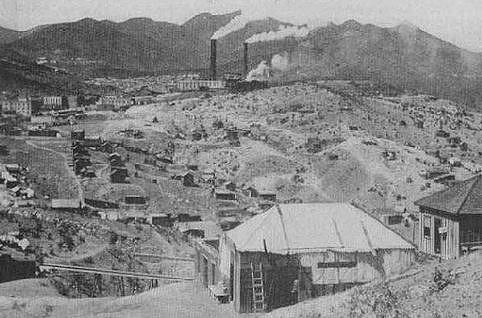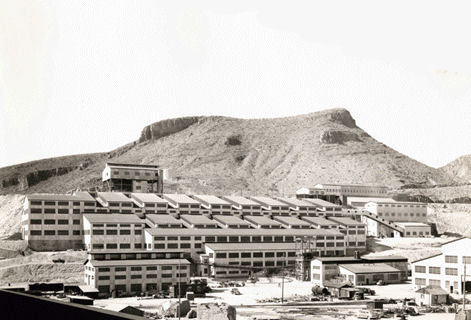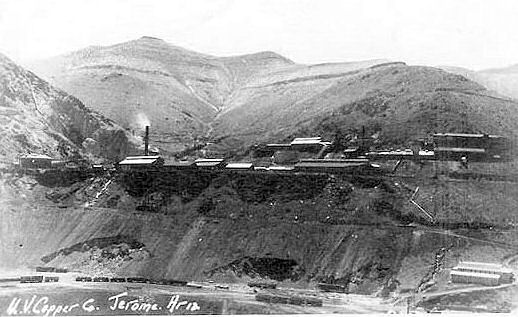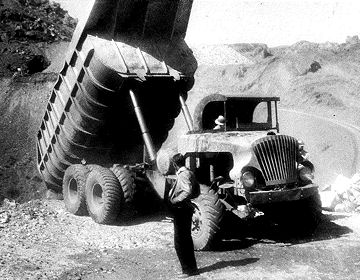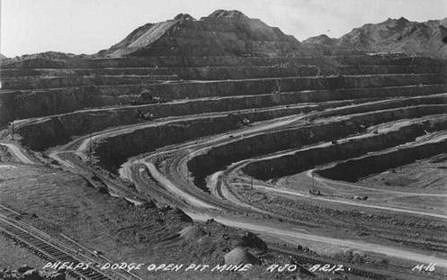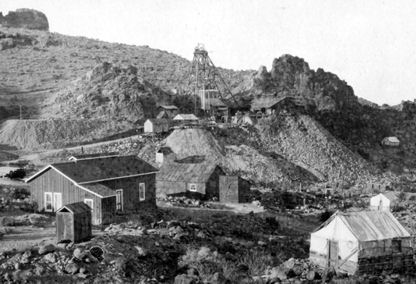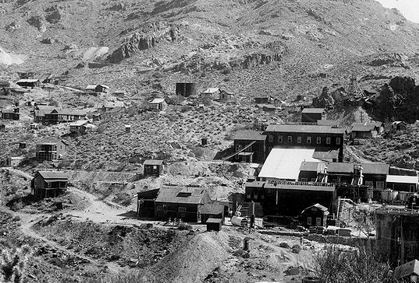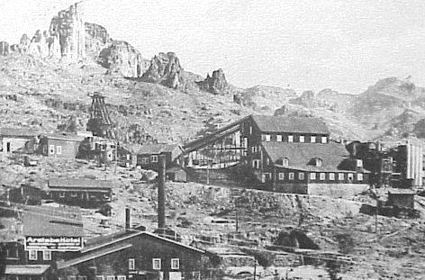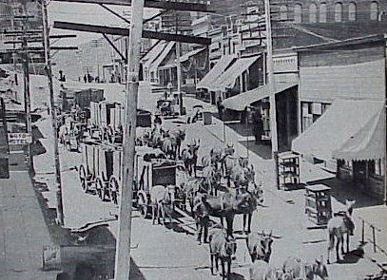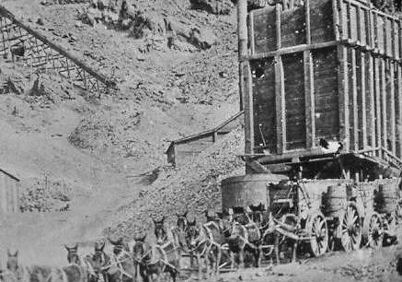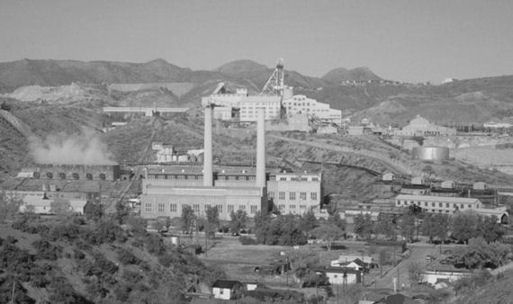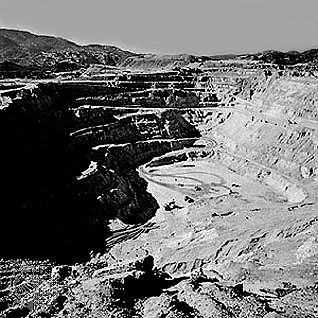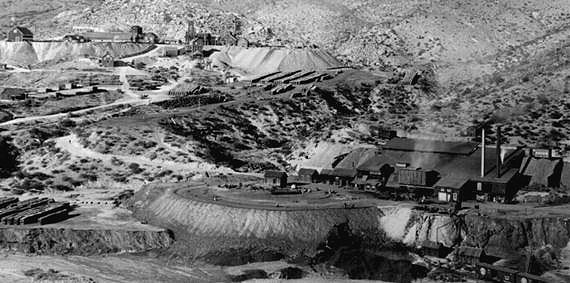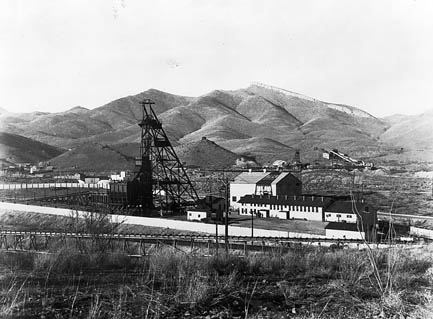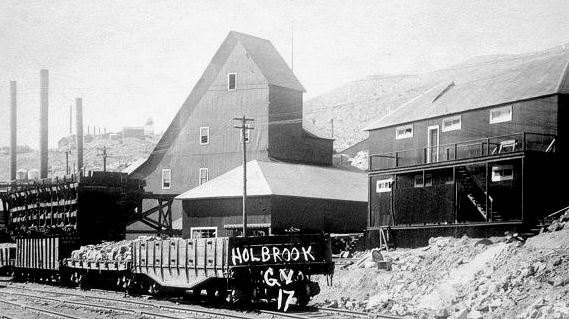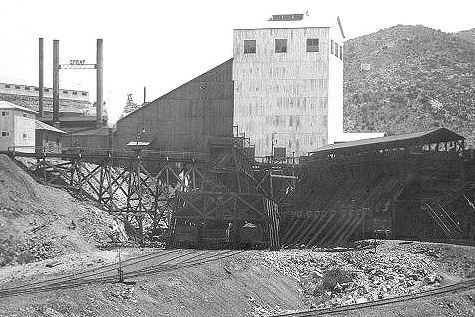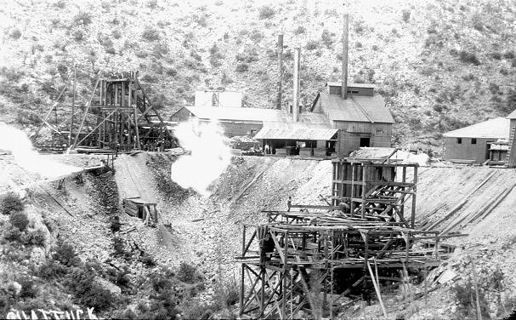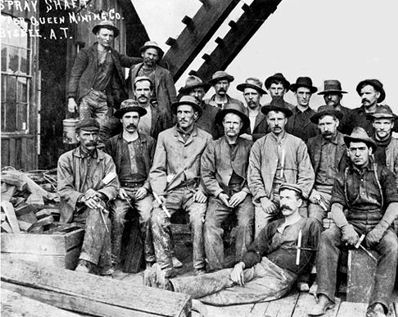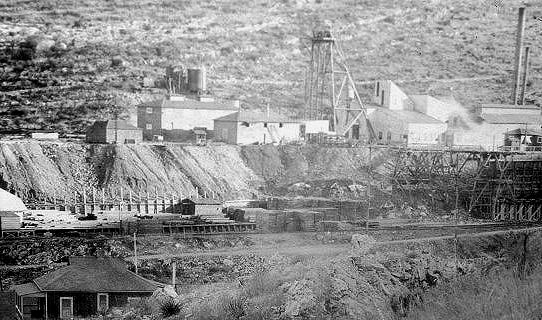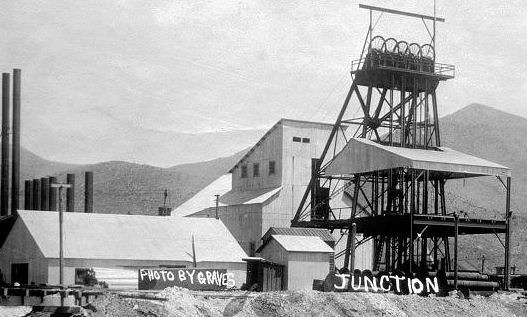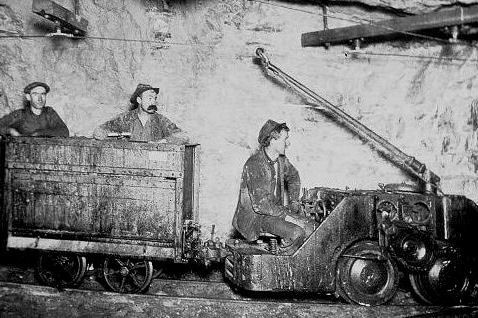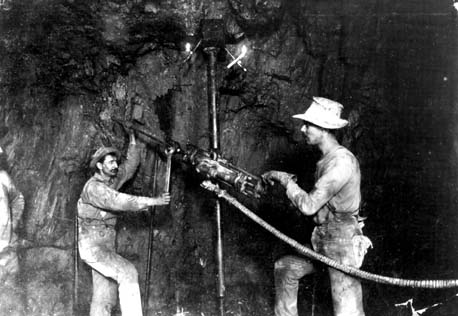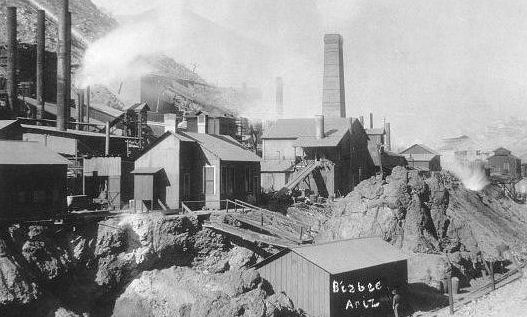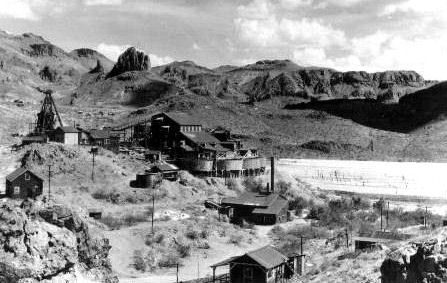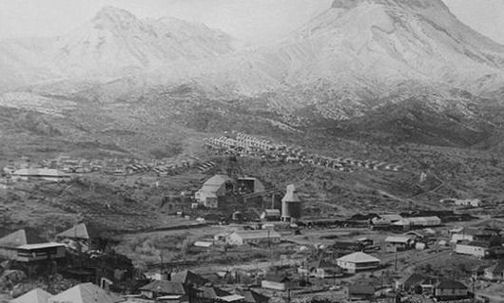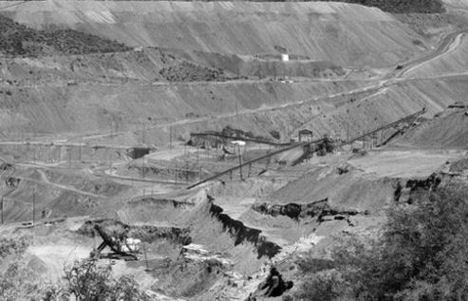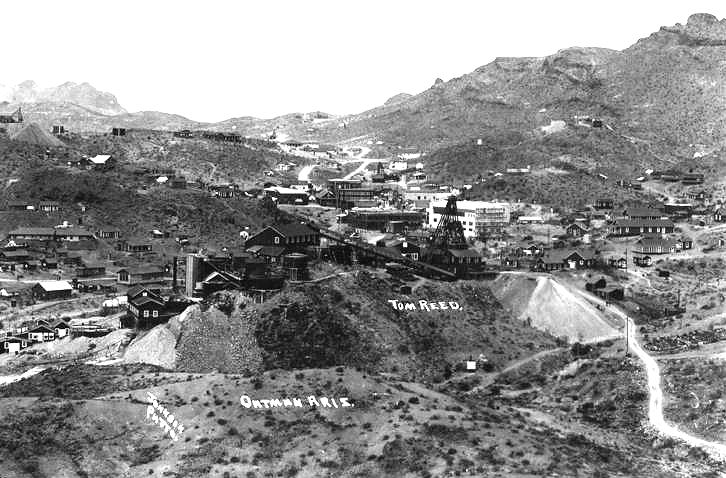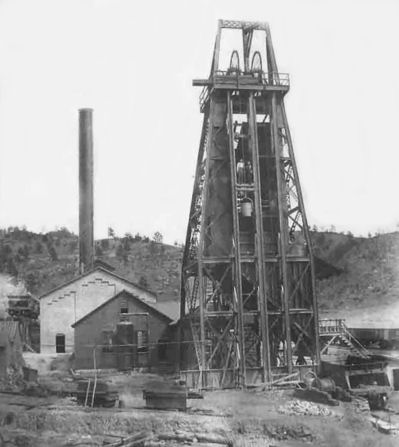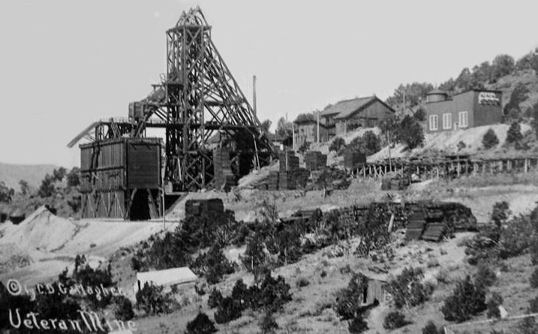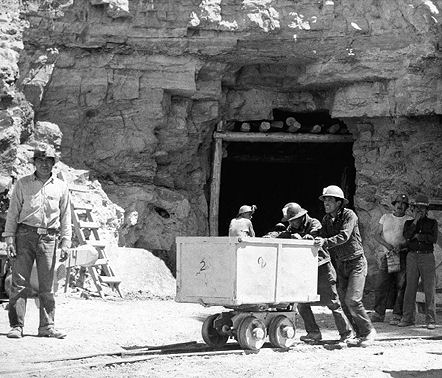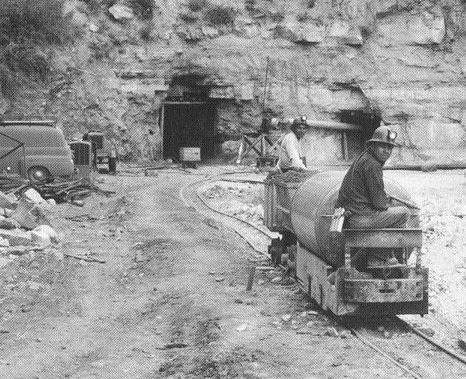ARIZONA MINES
Silver mining in Arizona was a powerful stimulus for exploration and prospecting in early Arizona. Cumulative silver production through 1981 totaled 490 million troy ounces. However, only about 10% of Arizona's silver production came from silver mining. More than 80% of the state's silver was a byproduct of copper mining; other silver came as a byproduct of lead, zinc, and gold mining.
Silver ore was first discovered in west-central Arizona in 1583 by Spanish explorer Antonio de Espejo, but no mining resulted. Again in 1598, Juan de Oñate led another expedition searching for Espejo’s silver; many claims were staked, but the expeditioners returned to Santa Fe without mining any silver, and the deposits remained unexploited. Espejo’s silver discovery is thought to be at the site of present-day Jerome, which later became a major copper-mining district.
Fortunately for miners the decline in demand for silver beginning in 1893 was matched with an increasing demand for copper. Although some prospecting, identification of sites, and even limited mining was done earlier, copper mining did not become important until the 1890s. In most cases the copper camps of the 1890s were camps that had earlier mined other minerals, usually silver.
Although copper mineralization was found by the earliest Spanish explorers of Arizona, the territory was remote, and copper ore could not be profitably mined and shipped. Early Spanish, Mexican, and American prospectors searched for gold and silver, and ignored copper. It was not until the completion of the Southern Pacific Railroad in 1876 that copper became broadly economic to mine and ship to market.Copper mining also produces gold and silver as byproducts. The byproduct molybdenum from copper mining makes Arizona the nation's second-largest producer of that metal.
The major copper mining has occurred in the the Clifton-Morenci District, Verde District around Jerome, at Ajo, the Warren District around Bisbee, and the Globe-Miami area, with limited mining occurring in the White Mesa District in Coconino County.
Ben Regan established the first claim at Globe in 1874. In 1881 Regan sold his claim to the Globe Mining Company. Also in 1881, the Old Dominion Mining Company was formed. One year later, the two firms merged, and Phelps Dodge entered the camp, buying some mines in the area. The Lewishon Brothers of New York bought the Old Dominion in 1895. The expense of freighting ore by 20 mule team wagons was eliminated when they built a railroad to the Southern Pacific at Bowie..
In 1876 claims were established in Central Arizona at the deposits first identified by the Spanish almost 300 years earlier. In 1880 Dr. James Douglas visited the camp and persuaded his New York clients to purchase the claims. When they sold an option to Eugene Jerome, he insisted the camp be named for him. These claims were incorporated as the United Verde Copper Company in 1882. The United Verde had rich ore but high transportation costs. Ore had to be freighted to Ash Fork, making it difficult to make a profit. In 1888 Senator William Clark of Butte, Montana bought the United Verde. Transportation costs were reduced by building a narrow gauge railroad to Jerome Junction to connect with the Santa Fe, Prescott, and Phoenix railroads, which provided rail transportation north to the main line at Ash Fork.
An army scout noted copper mineralization in the Mule Mountains, Warren district, at present-day Bisbee in 1877. Production began in 1880 after a rich discovery of copper oxide on the Copper Queen claim. Bisbee was founded as a copper, gold, and silver mining town in 1880, and named in honor of Judge DeWitt Bisbee, one of the financial backers of the adjacent Copper Queen Mine.The success of the Copper Queen mine convinced Phelps Dodge to buy the adjacent Atlantic claim in 1881. Phelps Dodge later bought control of the Copper Queen and adjacent claims.
The original claim to the Copper Queen mine was staked in 1877 by a prospector named George Warren, attracted by outcrops with the lead mineral cerussite, which often carried silver. An option on the mine was acquired in 1880 by entrepreneur Ed Reilly who raised $80,000 capital from Dewitt Bisbee to begin production. The surface pockets of cerussite were soon exhausted, but the owners found that the orebody ran 23% copper, with silver and gold as byproducts. Most mines of that era could profitably mine ore containing 3% or 4% copper, so the Copper Queen orebody was considered extraordinarily high grade. The surface oxide ore was exhausted after three or four years, but miners explored deeper and eventually found even larger orebodies.
In 1884-5 the mine was offered for sale to London investors for £350,000, but the offer was not taken up, and the mine was acquired by Phelps Dodge, which introduced a policy of racial segregation at the mine, with workers of Mexican origin not allowed to perform skilled jobs. In the early 20th century deposits of gold and silver were also discovered in the Copper Queen.
Although Phelps Dodge was the largest mining company in Bisbee, it was not the only one. The Calumet and Arizona company formed in 1901, and operated the large and profitable mine of the same name adjacent to the Copper Queen. By 1907, the Calumet & Arizona was the fourth-most productive copper mine in Arizona, and ran its own smelter in Douglas, Arizona. Their rich Irish Mag mine produced ore containing copper, lead, zinc, gold and silver. Another of their properties was the Junction Mine.
Mining in the Mule Mountains proved quite successful: in the early 20th century the population of Bisbee soared. Incorporated in 1902, by 1910 its population swelled to 9,019 and it sported a constellation of suburbs, including Warren, Lowell, and San Jose, some of which had been founded on their own mines. In 1917, open pit mining was successfully introduced to meet the heavy copper demand due to World War I. Phelps Dodge started mining the Lavender open pit in the early 1950s. Lowell was at one time a sizable mining town located just to the southeast of Old Bisbee. The majority of the original townsite was consumed by the excavation of the Lavender Pit mine during the 1950s.The Lavender pit closed in 1974.
The Copper Queen mine, Bisbee's first working mine, was also its last. Mining ceased in 1975, although the Copper Queen still offers tours.
The Warren district is credited with having produced 7.92 billion pounds of copper. In addition, the district recovered 324 million pounds of lead, 355 million pounds of zinc, 28 million pounds of manganese, 2.79 million ounces of gold and 102 million ounces of silver.
Copper Queen Mine - Bisbee, AZ
Underground - Bisbee, AZ
Underground - Bisbee, AZ
Father Eusebio Kino, in charge of the Spanish missions in southern Arizona from 1687 to 1711, noted a number of “minas” in the mountains bordering the Santa Cruz valley (present Santa Cruz County, Arizona), but the Spanish word “mina” can mean either a mine or an unexploited mineral deposit. A noted silver discovery in 1736 at Planchas de Plata, Sonora, just south of the present Arizona/Sonora border drew attention to the silver potential of the area. Later Spanish documents record mining in the 1770s in Quijotoa, Aribac, and Arivaca, in southernmost Arizona. Mining was held back because Arizona was the northern fringe of the Spanish frontier, and plagued by guerilla war with the Apaches.
When southern Arizona became a United States possession by virtue of the Gadsden Purchase in 1853, American prospectors and investors started mining silver deposits previously known to the Spanish and Mexicans in present Santa Cruz and Pima counties. The Santa Rita Mine in the Santa Rita Mountains and the Heintzelman Mine in the Cerro Colorado Mountains both started in 1856, the Mowry Mine in the Patagonia Mountains started in 1857, and the Salero Mine in 1858.
American prospecting and silver mining in the Santa Rita Mountains on the east side of the Santa Cruz Valley led to conflicts with the Apaches, known as the Apache Wars. One Apache raid killed all but one employee of the Santa Rita mine. Silver was discovered at Globe in 1873, and within three years numerous other silver mines were operating near Globe, Pinal, and McMillenville, in Gila and Pinal counties. Silver mining declined after the demonetization of silver in 1893, yet the boom in copper mining was soon producing more silver as a byproduct than had been produced during the bonanza silver days.
The main silver mining districts were in the Bradshaw Mountains at Tiger in Yavapai County, the Warren District at Bisbee, the Tombstone District and the Pearce District in Cochise County.
The real boom town of silver camps evolved from discoveries made by Ed Schlieffelin, prospecting in the southeastern part of the territory. Although army patrols from Fort Huachuca warned that prospecting in Apache land all he would find would be his tombstone, Schlieffelin persisted. When he struck it rich, in a bit of bravado, he named the camp Tombstone. Within a few months, hundreds of miners flooded into the camp. By 1881 Tombstone had a population of 4,000, making it Arizona's largest town and the biggest community between New Orleans and San Francisco.
As Arizona's mining companies became larger and more impersonal, silver miners formed societies and unions to provide work and social benefits. In 1884 Tombstone's miners formed a union affiliated with the Knights of Labor and demanded a pay increase. In 1886 fire swept the camp destroying much of the town. The 1893 repeal of the Sherman Silver Purchase Act was the final straw. The mines began to shut down, and Tombstone, despite its boast of being "The Town Too Tough To Die," began to wither away. By 1893 it had produced $22 million and would eventually produce another $13 million, but its boom was over.
Francis X. Aubry reported seeing evidence of gold in the Colorado River in 1853 but felt it was of little value, and nothing was done to develop it. Five years later, Arizona's first major gold rush occurred when Jacob Snively led a party of prospectors to a placer deposit on the Gila River about 19 miles east of its juncture with the Colorado River. A booming camp, Gila City soon developed. By 1861, there were 1,000 miners in the camp. Despite early riches and fast growth, the Gila City placer deposits soon played out.
The next important placer strike occurred in 1862 when the ex-mountain man, Paulino Weaver, led a group of prospectors to the Colorado River above Yuma and discovered the La Paz placer deposits. A major camp quickly developed. By year's end La Paz had 5,000 residents, was important enough to be the first county seat of Yuma County.
Early view of Tough Nut Mine - Tombstone, AZ
Unidentified mine near Tombstone, AZ
Prospector near Tombstone, AZ
In 1863, Henry Wickenburg prospected up the Hassayampa River, near what is present day Wickenburg. Legend has it that Wickenburg threw a rock at a vulture (some say at his burro). When the rock broke, Wickenburg saw that it contained gold ore. Although 12 miles from the river, Wickenburg established a claim. Wickenburg soon sold the mine (named the Vulture Mine because of the story of its origins) for $68,000. The newly formed Vulture Mining Company announced plans to introduce modern mining methods, and to build a twenty-stamp mill on the Hassayampa River. The stamp mill site was to be twelve miles to the northeast, about one mile north of an existing settlement on the river.
Although productive until well into the 20th century the Vulture Mine had many problems, including the degree of high-grading by the miners and wagon freighters. From 1863 to 1942, the mine reported producing 340 thousand ounces of gold and 260 thousand ounces of silver, not counting what was high-graded, making this the single most propductive gold mine in Arizona.
In 1855, San Franciscan, Charles D. Poston (the Father of Arizona), formed a party to search for abandoned Spanish mines in Sonora. The party sailed up the Gulf of California and traveled overland to the Tubac area where they located previously worked mines. Returning to San Francisco, Poston was able to get enough financial backing to form the Sonora Exploring and Mining Company and open several mines in the Tubac area. By 1858 Poston employed more than a thousand Mexican miners.
Unidentified Arizona mine
Morenci Concentrator
Clifton-Morenci, AZ
A group of men from Silver City, New Mexico staked claims in Arizona in 1872, establishing the camp of Clifton. The group included the Metcalf brothers, Jim and Bob. They were able to persuade others, including the Lezinsky brothers, to grubstake their operation. The mining camp that developed was named Morenci, after a town in Michigan.
Continuing the Michigan connection, The Detroit Copper Company was organized in Clifton/Morenci. Because of the terrain, the Lezinsky brothers developed a narrow gauge railroad and a long incline from the Longfellow mine down to the smelter. Originally mule drawn, it later used a small, narrow gauge engine, which was the first in Arizona. Between sixty and eighty tons of rich ore were smelted daily and carried by wagon to La Junta, Colorado. The brothers sold out to a Scottish syndicate, the Arizona Copper Company, in 1882. About the same time, William Church persuaded the Phelps-Dodge Mercantile Company to invest $50,000 in his operation. When he finally retired in 1895, Church sold his interest to Phelps Dodge.
In 1847 Tom Childs, Jr. led a party of 19 Americans into present-day Arizona to help locate the legendary Plancas de Plata, where early silver lodes had been discovered. Before being turned back by Mexican nationals, Childs was able to locate abandoned copper mines at Ajo Describing the Ajo mines as "open cuts in the hillsides and a shaft at least 60 feet deep", Childs said there were still notched ladders and leather ore buckets in the unworked shafts.
High-grade native copper made Ajo one of the first copper mines in Arizona. Soon the Arizona Mining & Trading company, formed by Peter M. Brady, a friend of Childs, worked the rich surface ores, shipping loads around Cape Horn for smelting in Swansea, Wales, in the mid 1880s. Long supply lines and the lack of water discouraged large mining companies
With the advent of new recovery methods for low-grade ore, Ajo boomed. In 1911, Col. John Campbell Greenway, a Rough Rider and star Yale athlete, bought the New Cornelia mine from John Boddie. He became general manager of the Calumet and the Arizona mining company and expanded it on a grand scale. In 1921, Phelps Dodge, the nation's largest copper company, bought New Cornelia and the mine became the New Cornelia Branch of Phelps Dodge, managed by Michael Curley. For several decades more than 1,000 men worked for Phelps Dodge in the open pit mine. The mine closed in 1985
Morenci Open Pit Mine
It was William A Clark who put Jerome on the map by purchasing the United Verde Copper Company in 1888 for $80,000. Clark is best known as one of the three "Copper Kings" of Butte, Montana, along with Marcus Daly and F. Augustus Heinze. It was Clark who was responsible for bringing in the narrow gauge railroad which boasted 187 curves and 28 bridges in the last 14 miles of its 27 mile run, making it one of the largest copper mining operations in Arizona. In 1935, Phelps Dodge Mining Corp. puchased the United Verde Copper Company for $22,800,000.00 and operated the mine until its closing in 1953.
Besides the usual mining camp difficulties with water and fire, Jerome had an unusual problem. It was built on a fault. This made following the vein difficult and later, as a result of extensive tunneling and blasting, would cause the camp to slide downhill. To the east of the fault, the Little Daisy Mine, incorporated as the United Verde Extension after years of exploration, hit 45 percent copper ore. Developed by James Douglas and Phelps Dodge, the United Verde Extension produced $125 million in ore. In 1935 after the death of Clark, Phelps Dodge bought the United Verde. By its closure in 1953, Jerome had produced over $600 million in gold, silver, and copper.
United Verde Copper Co. - Jerome, AZ
Ore Wagons on Main St of Jerome, AZ
Loading ore wagons at Jerome, AZ
The Globe Ledge was recorded on September 19, 1873. The Globe mine was located in that year by Ben Reagan, Robert and David Anderson, Isaac Copeland, William Sampson, William Long, T. Irwin and others. The first settlement in the newly opened mining area was at the Ramboz Mine. Here the Globe Mining District was organized in November 1875 in the Globe Hills. Ramboz settlement was moved prior to 1878 to Globe, probably because there was ample water at the latter place and because it was also better situated as a general distributing point.
When the community was initiated it was referred to as Globe City, a name which continued until the publication of the Arizona Silver Belt on May 2, 1878 in which the editor suggested that the word "city" be dropped. The town site had been laid out earlier by Alec Pendleton. In October 1880, Globe was incorporated as a village, but this fact seems to have been forgotten after 1884. The result was that the town of Globe was again incorporated in 1905. Its citizens found city government too expensive and disbanded the incorporation within a year. It was re-incorporated as a city in 1907.
Gold Road Mine - Gold Road, AZ
Gold Road Mill and Mine Shafts No.1 & No.3.- Oatman District, AZ
Tom Reed Mine - Oatman, AZ
Miami, AZ
Open Pit Mine - Globe, AZ
Mines - Globe, AZ
Campbell Shaft, Copper Queen Mine - Bisbee, AZ
Holbrook Mine - Bisbee, AZ
Spray Shaft, Copper Queen Mine - Bisbee, AZ
Shattuck Mine - Bisbee, AZ
Copper Queen MIners
Lowell Shaft - Bisbee, AZ
Calumet & Arizona Company, Junction Mine - Bisbee, AZ
Underground - Bisbee, AZ
Underground - Bisbee, AZ
"In 1900, the site that was to become Superior appeared on a map of the Pioneer Mining District as Hastings, but the name changed in that year due to the work of George Lobb, who laid out a town site for a community to be called Superior because of the existence of the town depended upon the operations of the Arizona and Lake Superior Mining Company. By 1904 Superior had many tents, several primitive board homes, a store, boarding house, blacksmith shop, and a post office with Lobb as postmaster. With the construction of a huge smelter in 1914 by the Magma Copper Company, the future of Superior in the roster of Arizona communities was secured to last as long as copper ores continued to be fed into the smelter. In 1981, the smelter closed down.
Frank Schultz located the first mine in the Mammoth district and as early as December 27, 1872, the Mammoth Mine was being worked by E. M. Pearce, C.O. Brown, and members of Tully Ochoa Company. This mine, sometimes referred to as the Old Mammoth Mine, was at a place referred to as Shultz after its locator, or sometimes as Mammoth Camp. Because ores could not be milled at the site, a stamp mill was constructed on the San Pedro River where the community of Mammoth is today. Ores were sent down from the mine to the town in buckets suspended on a wire cable and the returned buckets were filled with water for the mining camp. The Mammoth Mine was so named because it was said to contain huge ore veins.
During the 1840s prospectors began to canvas the area that was to become Chloride for any sign of precious minerals and in the early 1860s they stumbled upon several rich silver veins on a site they called Silver Hill. Later they would find other riches including, gold, lead, zinc, copper and turquoise in the area. The mining camp of Chloride was founded around 1863, but despite the vast riches of the district, it grew slowly due to the hostile Hualapai Indians. However, the Butterfield Stage Line began to service Chloride and the surrounding area in 1868. In the late 1860s the U.S. Army began to subdue the Hualapai and by the early 1870s a treaty was signed with the Indians, clearing the path for extensive mining.
It was during this decade that the population began to escalate and in 1873 a post office was built. Soon, all manner of new business began to spring up in Chloride. In 1898, the Sante Fe Railroad extended its tracks from Kingman to Chloride, dramatically reducing the costs for ore and supply shipments. Just two years later the town boasted a population of 2,000, supported primarily by two major mines, the Tennessee and the Schuykill. Both these mines would produce gold, silver, lead and zinc on a major scale up into the late 1940s.
Chloride’s peak years were between 1900 and 1920, when some 75 mines were in operation in the area. In 1910, the railway was again extended directly to the Tennessee Mine, the largest in the area. With the coming of the railroad, Butterfield’s Stage Line finally discontinued service in 1919. By the 1930s, the richest mine in the area was the Golconda, located between Kingman and Chloride. It has been estimated that the Golconda produced six and a half million dollars in ore. Later on, the Tennessee Silver Mine surpassed the Golconda in total ore produced.
Black Jack Newman located the Mima Mine, naming it for his fiancee, Mima Tune, whom he later married. This mine was east of the Old Dominion Globe Mine in Big Johney Gulch. Almost simultaneously, James F. Gerald, who represented a group of men from Miami, Ohio contstructed a custom mill on what was then called the West Branch of Pinal Creek, but later Miami Wash. The mill was on a hill which is cut by the railroad where it crosses the Apache Trail. The flat in front of the mill was called Miami Flat for the Miami Copper Company, which owned mill and mine. Gradually, the names Mima and Miami became so blended that the original intention to call the new community Mima was overlooked.
Beginning in 1907, the town of Miami came into existence practically overnight, and its growth was insured by the Inspiration Mine company, which began constructing a huge reduction plant in 1909, Miami is sometimes referred to as the "Concentrator City".
Just across the Colorado River and up the hill from Laughlin, Nevada is the town of Oatman, Arizona. In its heyday, from the early 1900s to the 1940s, Oatman and the nearby town of Gold Road were the largest producers of gold in Arizona. Gold was first discovered in Oatman in 1902 by Ben Taddock who, while riding along the trail, saw free gold glittering on the ground and immediately filed a claim. A tent city soon sprang up as other miners heard of the gold find and rushed to the area.
Lacking the funds to develop a mine, Taddock sold his claim in 1903 to Judge E.M. Ross and Colonel Thomas Eqing, who in turn sold it to the Vivian Mining Company. The mining camp was named Vivian. Between 1904 and 1907 the mine yielded over $3,000,000. In 1909 the town changed its name in honor of Olive Oatman, who was kidnapped as a young girl by Apaches. The Tom Reed Mine was established in 1910. The new Tom Reed Mine breathed new life into the town, just as the Vivian Mine was about to close.
In 1915, two miners struck a $14 million gold find, providing yet another boom to the settlement.
Gold Road stands in a canyon just beyond Sitgreaves Pass when traveling westbound Route 66. Prior to the town’s beginning, a man named John Moss discovered traces of gold in the area during the early 1860s, but when silver was found in abundance in the Cerbat Mountains, Moss abandoned his diggings and headed north to the Chloride area.
That didn’t stop prospectors from swarming all over the mountains and in 1900 a miner by the name of Jose Jerez hit "pay-dirt.” Grubstaked in the amount of $16.00 by store owner, Henry Lovin of Kingman, Jose was searching for his lost burro when he literally stumbled over a rich ledge of gold-bearing quartz.
Jerez packed up samples and took it to an assay, where he found it assayed at 40 ounces to the ton. Immediately, he contacted his partner, Henry, and the two wasted no time returning to the site to start digging. Within just a few months, they dug a 15-foot shaft. Their frenzied activity soon attracted the attention of a California group who bought their claim for $50,000 in 1901.
The California group soon sold their right to another group of investors for $275,000, who brought in the necessary equipment and built a mill to operate a large mine. Soon 180 miners were bringing up hundreds of thousands of dollars in ore. Around the mine, a settlement sprang up with a number of new businesses. The post office was established on April 15, 1902. Henry Lovin used his money to open a new store in Gold Road, a successful freighting company, and the Gold Road Club.
The Gold Road Mine peaked during 1905 and 1906, but the following year the rich veins began to give out and the mine closed. It was estimated that more than two million dollars in ore was taken from the mine during its short duration. However, the immediate area surrounding Gold Road continued to be a haven for other miners until 1931. In total, the district took in over seven million dollars worth of gold during this period.
Tom Reed Mine - Oatman, AZ
Ray, AZ with the Ray Mine in the lower center
Ray Mine after it comsumed the townsite
Coal Mine - Sunrise, AZ
Veteran Mine - La Paz County, AZ
Navajo Miners- Kerr-McGee Uranium Mine - Cove, AZ
Navajo Uranium Miners - Cove, Apache County, AZ
Uranium mining started in 1918 in the Carrizo Mountains, as a byproduct of vanadium mining. The district is in Apache County, in the northeast corner of Arizona. The uranium and vanadium occur as carnotite in sandstone of the Salt Wash member of the Morrison Formation (Jurassic). Production stopped in 1921. Another successful period of mining took place from 1941 to 1966, producing 360,000 pounds of uranium oxide.
A Navajo discovered uranium in 1942 in Monument Valley on the Navajo Indian Reservation in northeast Arizona. The first mine in the district opened in 1948. Uranium and uranium-vanadium minerals occur in fluvial channels of the Shinarump Sandstone member of the Triassic Chinle Formation. Ore deposits are associated with carbonized wood in the sandstone. Mining stopped in the Monument Valley district in 1969, after producing 8.7 million pounds (3900 metric tons) of uranium oxide, more than has been produced from any other uranium mining district in Arizona.
In 1948, a copper deposit in the Moenkopi Formation was discovered to have economic concentrations of uranium. The deposit was in the Lukachukai Mountains of Apache County. Uranium totaling 3.5 million pounds of uranium oxide was produced from 1950 until the mines closed in 1968.
Navajo prospector Hosteen Nez found uranium near Cameron in Coconino County in 1950. The uranium is in the Kayenta Formation and the Chinle Formation. Production was from 1950 to 1963, and totaled 1.2 million pounds of uranium oxide.
